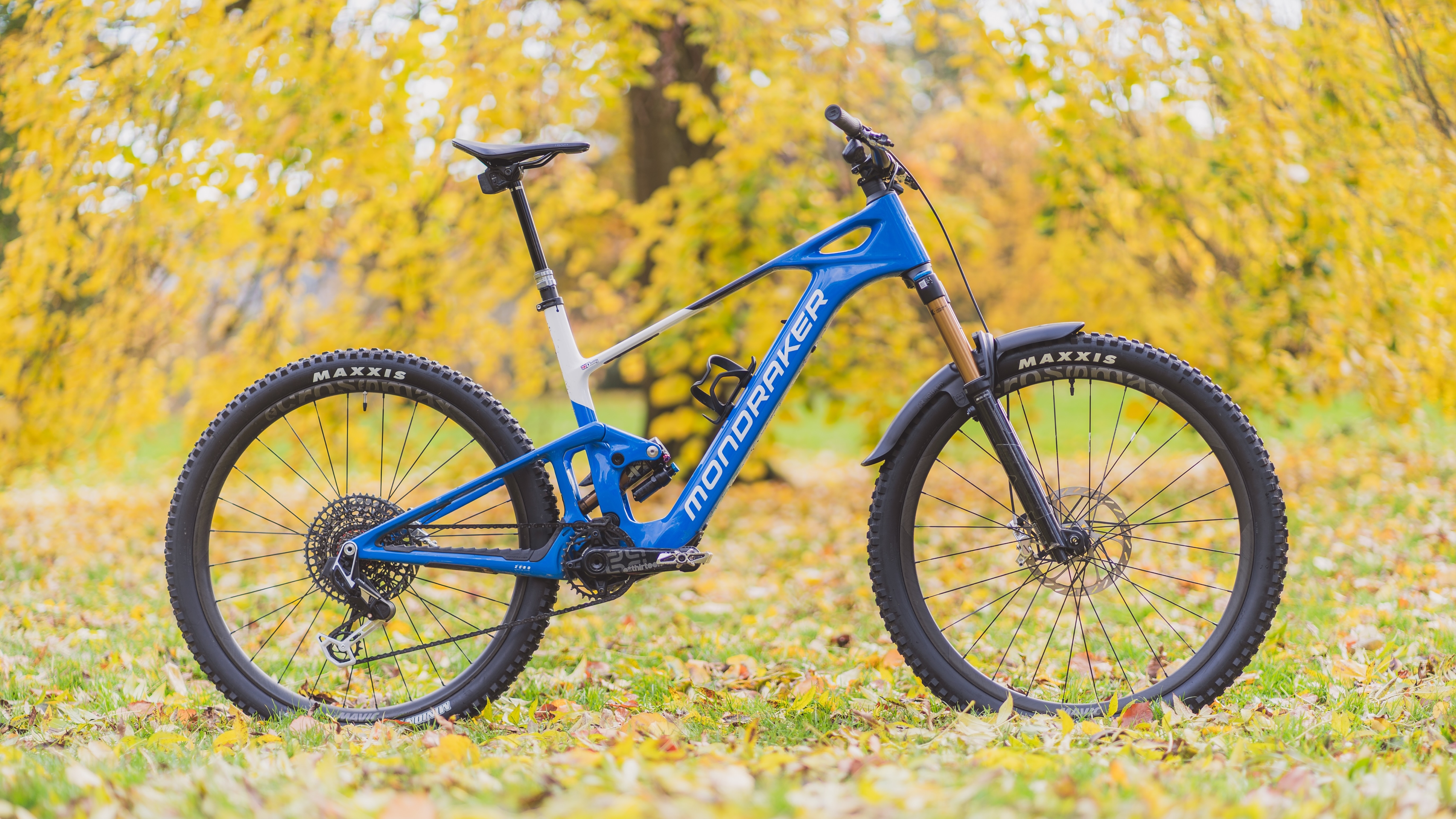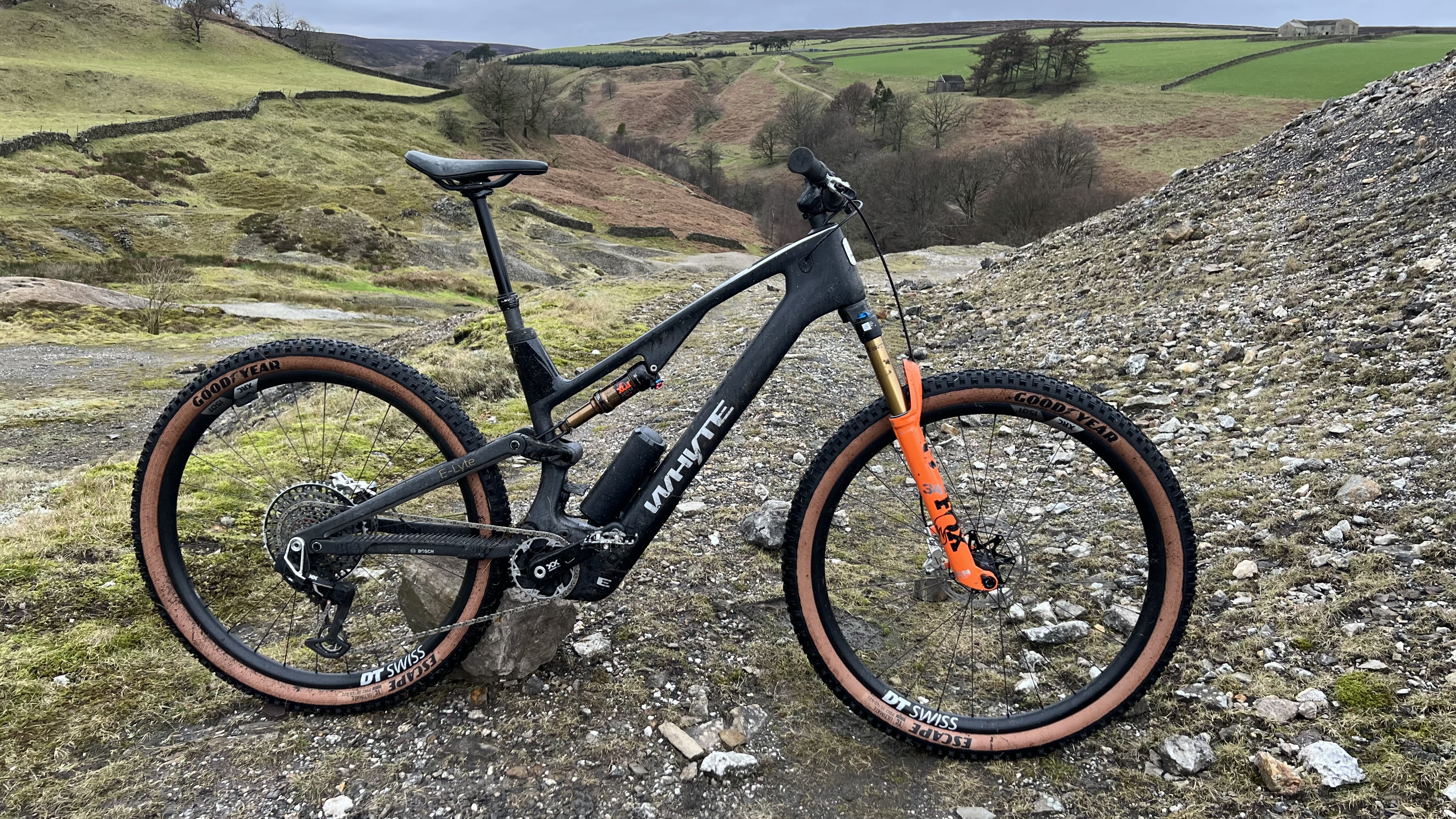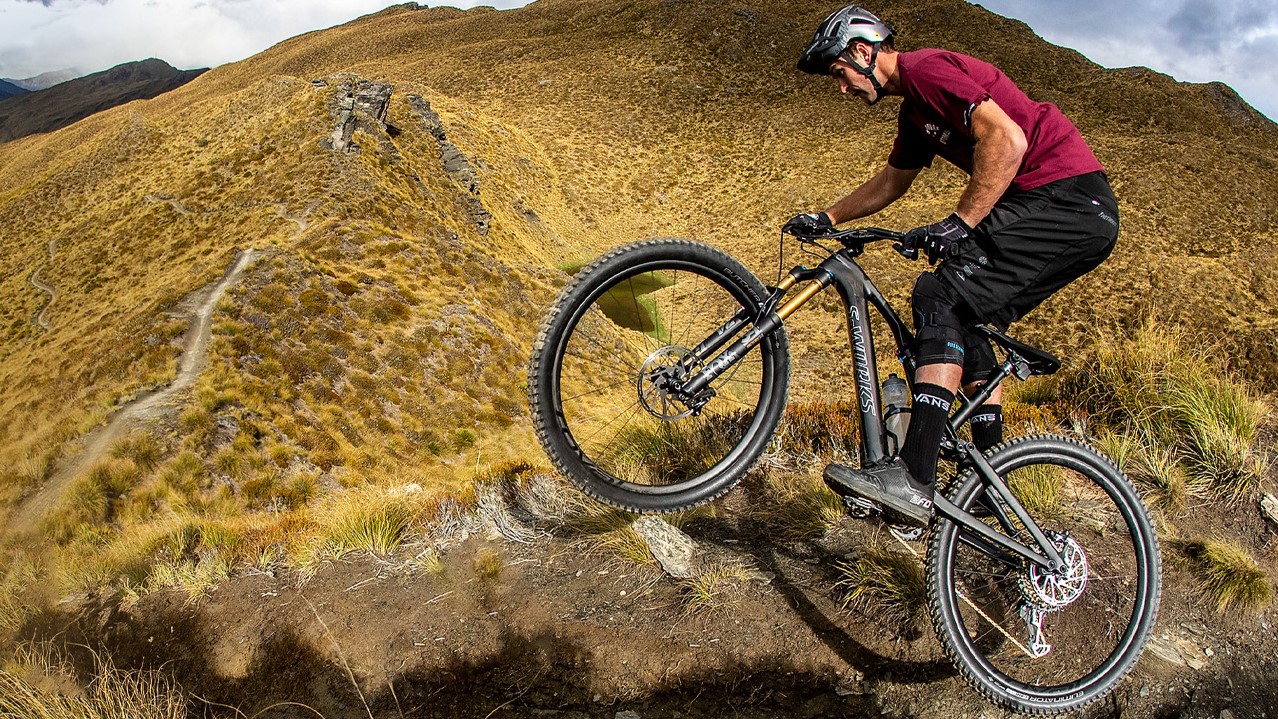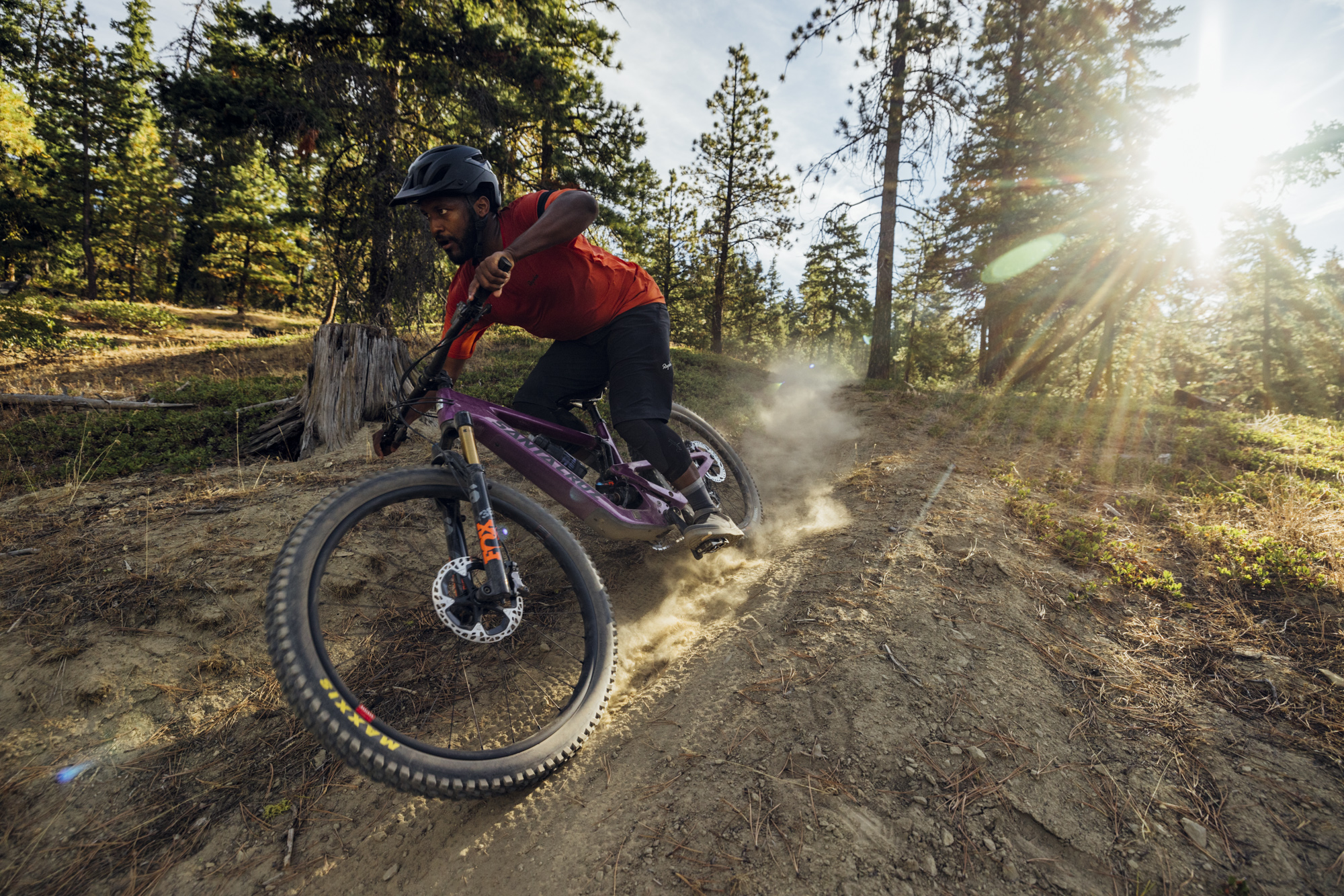
One of the most important things as a tester is to have a healthy distrust of hype. So to keep the doubters happy in a landscape that seems to be becoming ever more dominated by electric evangelists, let’s start out on the bad foot of the lightweight e–MTB discussion.
First, cost. Comparing a conventional bike like the Specialized Stumpjumper Evo Carbon to it’s Specialized Levo SLII carbon electric e-MTB equivalent, you’re looking at an RRP of £4,650 versus £7,000. However, like a lot of purely meat moved MTBs these days, Specialized are selling off surplus Stumpys for under 4k. Meanwhile, the post-Covid Levo SL is still in demand so doesn’t need reducing in price. Cynics might suggest this is why the bike industry is desperate to push the latest genre agenda, because lightweight e-MTBs are about the only bikes they’re not needing to yard sale right now. But more on that later.
Now what about weight? The language around the lower powered, smaller motor and battery e-MTBs is peppered with ‘lightweight’ or even ‘superlight’ claims. The ride narrative is all about being "agile" and “feeling just like a normal bike”. To be fair, a Bosch SX motor is a kilo lighter than a Bosch CX, and given the same cell quality and tech, a 360Wh battery is roughly half the weight of a 720Wh. So yes, compared to most full power e-MTBs, you are saving 3-4kg and that matters when you’re heaving a bike over an obstacle or into/out of a car. Bigger batteries always leave more mass sitting higher in the frame, so trying to muscle that around on the trail makes a bigger proportional difference to a lighter, lower mass.
But truth time here, all this talk of 'lightness' is relative. While individual designs vary, you’re still looking at something like 2kg for a motor and 1.7 to 2kg for most batteries, plus the weight of whatever switchgear and display you’re running, as well as motor / battery mounting hardware over and above a conventional frame. So even though the latest e–MTB frames like Mondraker’s new NEAT apparently only weigh a downcountry bike comparable 2.3kg as a basic carbon shell, you’re looking at 6kg+ once all the electrics are added. A tire getting crushed between the trail and 17-18kg of speed boosted bike likely needs to be tougher, or at least protected with an insert and that’s before brakes, forks and shocks get upsized.

Electrics don’t just add weight, they also add a lot of extra water, dirt and vibration sensitive components into an often very wet, dirty and rattly environment. Unless it’s a simple connector issue, e–MTB problems tend to be impossible to sort trailside too. And while motors like TQ, Levo SL, Fazua and Bosch SX are essentially drag free, you’re still pedaling a lot of dead weight around if your motor or battery won’t play ball.
Plus, there’s no way to get around the fact that while they add the same level of complexity and potential reliability issues, lighter motors don’t give the obvious power boost of a 'full fat' setup. The 450W Fazua 60 and 600W Bosch SX still have the grunt to get involved when you’re sprinting, but put the hammer down with the current TQ and Levo SL motors and they can’t keep up. Add short range from small batteries if you use the higher power modes, and that’s going to leave the ‘turbo/boost all the time', winch and plummet crew wondering what the point is.

So what is the point?
These realities are something I’ve been thinking about a lot in the past two months while testing the new Whyte E–Lyte 140 Works and it’s longer travel, more trail oriented E–Lyte150 RSX sibling. As I say, there’s so much hype around these bikes at the moment, it’s easy to get caught up in the literal buzz around them. The bottom line is that they’re more expensive, heavier and less reliable than a non-powered bike, but they don’t give you as much boost or range (depending which you prioritize) as a full fat e–MTB.
But then the mountain bikes that nearly all of us ride are a compromise compared to the extremes. Unless you’re riding a stripped out XC bike, you could have a more effortless experience on climbs. Unless you’re riding a DH bike with race rubber on, you’re not getting as much DH control as you could. And having spent a lot of time on lightweight e–MTBs in the past year and watched how other people have ridden test bikes I’ve lent them, it’s clear that they really do have a valid place in modern mountain biking.
With 600W of peak power but less weight, the Whyte E-Lyte is genuinely competitive with a ‘full fat’ e-MTB in terms of acceleration and short burst climbing. It’s a properly rewarding bike to push hard on through the pedals and has a real ‘hunt and hustle’ race vibe even when stand up sprinting. If you go faster than the motor is legally allowed to help with, the latest generation motors are essentially drag free so it doesn’t feel like you’ve hit a wall. Even in Eco mode I was getting a definite advantage over unpowered riders on climbs or contouring singletrack. I still managed a 114km totally off-road trail centre ride at 18.3kmh average with the 250Wh PowerMore auxiliary battery plugged into the 400Wh onboard cells.
The way they ride is very different to full fat e–MTBs too. Lower power motors don’t spin back wheels or surge wheelie as easily, so they feel a lot more natural to ride and control. While some riders prefer the superhuman feel of a 90Nm motor, I like the way the lower torque Whyte just makes me feel I really did do the over winter training I promised I would do before life got in the way again. That’s a totally different feel in terms of reward, satisfaction and fitness gain than blasting everywhere in boost or turbo. Pick a TQ bike or a Levo SL and you’ll barely be able to hear the motor either, and together with Fazua 60 bikes, they’re basically invisible aesthetically too.

There are loads of other use cases where these bikes really shine as well. I lent the Whyte to UK MTB marathon champion and top five Elite XC racer, Amy Henchoz, to coax her out on our 'Thursday Night Fight Club' ride – even though she was meant to be resting – and she loved it. Amy happily sat in her recovery zone the whole night while keeping pace with the rest of us at the ragged edge. If you added a Kiox head unit to the Whyte or used a TQ bike or Levo SL, you’d have your own personal wattage data on screen. This is why a lot of racers now use e–bikes for steady state training while still having a lot more fun than they would on a road bike and building their skills in the process.
We’ve got riders who’ve bought Santa Cruz’s new Heckler SL so they can join us on more XC rides they wouldn’t be able to otherwise. And lightweight e–MTBs work for them because they don’t need to blast ahead and don’t want to lug excess, awkward to handle mass about or be screwed when I accidentally lead them into another swamp or hike-a-bike. I’ve talked to people on the trail who’ve been able to carry on doing distances, speeds and terrain they couldn’t have dreamed of on a normal bike. But they now don’t have to worry about being stuck if a bridleway gate has been locked or a log is blocking the trail instead. I’ve also met several lighter riders in shops who need some help to keep up with mountain biking friends or a partner, but their current big e-bike is an overkill that they’re totally over.
There are enough options in terms of spec and capability to find a lightweight e–MTB to suit your riding perfectly. At the risk of making it sound like a gravel bike a speed and distance optimized bike like Whyte’s E–Lyte 140 Works, Rotwild’s R.X275 or Scott’s Lumen won’t feel over-biked on easier local trails. They've also got the range to pedal from the door into the backcountry, but still be able to handle the wild stuff. While those aren’t the rides that produce the most spectacular images or talked about much by media, they are the rides that the majority of ‘forgotten mountain bikers’ have been doing for decades. And now they’re getting to the age where a little electric help literally goes a long way, so e–MTBs are allowing rides they never thought they'd do again.
More capably equipped bikes like the Trek Exe, Specialized Levo SL, Santa Cruz Heckler SL, Orbea Rise, Mondraker Neat, Whyte E–Lyte 150, Lapierre E–Spicy, Haibike Lyke etc. give riders the control to really push on technical terrain. But with the power to weight ratio that lets them play rather than plough while still getting two runs of their favorite descent in the time one run would take without a motor.

If you don't like it, don't buy it
The final point is that like any other new option introduced into mountain biking you don’t have to buy into it. Sure, we’re seeing manufacturers slimming down their ranges of conventional bikes. But that’s because they’re not selling like they used to, not because they’re trying to force you into using a motor. And they’re not selling because a lot of people are wanting to motorize their mountain biking and ignoring conventional bikes even when the prices have come crashing down.
And I can see why, as while I’m hopefully a long way off needing an e–MTB to do the riding I like doing, I’m certainly looking forward to testing a lot more lightweight e–MTBs this year. Not just because they feel a lot more like ‘honest’ mountain biking than something that’s just short of a Surron e-dirt bike, but some days I want to finish a 100km+ trail ride with the 'zoomies' not the 'zombies'.







